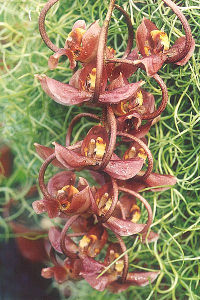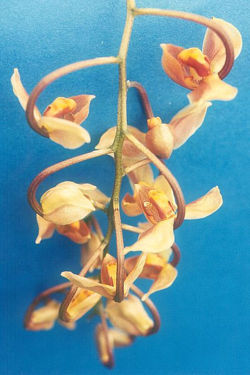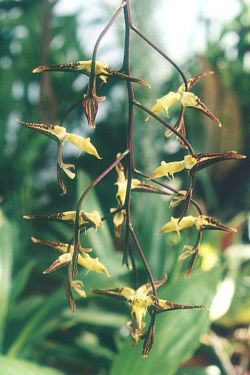Gongora
| Gongora subsp. var. | ||||||||||||||||||||||||||||||||||||||||||||||||||||||||
|---|---|---|---|---|---|---|---|---|---|---|---|---|---|---|---|---|---|---|---|---|---|---|---|---|---|---|---|---|---|---|---|---|---|---|---|---|---|---|---|---|---|---|---|---|---|---|---|---|---|---|---|---|---|---|---|---|

|
|
| ||||||||||||||||||||||||||||||||||||||||||||||||||||||
| ||||||||||||||||||||||||||||||||||||||||||||||||||||||||
{{{name}}} LATINNAME
|
'
| ||||||||||||||||||||||||||||||||||||||||
|---|---|---|---|---|---|---|---|---|---|---|---|---|---|---|---|---|---|---|---|---|---|---|---|---|---|---|---|---|---|---|---|---|---|---|---|---|---|---|---|---|---|

|
|
| |||||||||||||||||||||||||||||||||||||||
| |||||||||||||||||||||||||||||||||||||||||
| Standard Cyclopedia of Horticulture |
|---|
|
Gongora (after Don Antonio Caballero y Gongora, Bishop of Cordova). Includes Acropera. Orchidaceae, tribe Vandae, subtribe Cyrtopbdieae. A small group of plants with curious spotted flowers, not common in cultivation, and of little value except for collections. Distinguished from the other members of the sub- tribe by being epiphytic, having the dorsal sepal adnate to the column, and by its many-fld. raceme: dorsal sepal erect, spreading, thus appearing to spring from the base of the column; lateral sepals spreading or reflexed from the base of the column, wider; petals small, adnate to the base of the column; labellum continuous with the column, narrow and fleshy, with 2 thick lateral horned or aristulate lobes, and a central one which is saccate or even folded, forming a vertical plate; column erect or ascending, not winged: pseudobulbs sulcate, sheathed, bearing 1 or 2 large, plicate lvs.: fls. borne in a long, loose, pendent raceme arising from the base of the pseudobulbs.—Over 20 species from Brazil to Mex. Gongoras are extremely free-flowering, and grow easily in a mixture of sphagnum and peat, with a little charcoal added for drainage. During the growing season they require plenty of water, and brisk heat. In the winter they require little water, but should be kept in a moist atmosphere in a cool, shaded house. They grow well with cattleyas, or in a temperature of 60° in winter and 80° in summer. Some growers prefer to use fine fern root packed tightly and for a top finish a little fine moss found in damp meadows, instead of sphagnum, which in this climate is quick to decay. CH
|
Cultivation
- Do you have cultivation info on this plant? Edit this section!
Propagation
- Do you have propagation info on this plant? Edit this section!
Pests and diseases
- Do you have pest and disease info on this plant? Edit this section!
Species
According to Rod Rice in Infragen. Rev. Gen. Gongora (2002, 2003) the genus Gongora can be classified into subgenera and sections as followswp:
Subgenus Gongora wp
- Section Aceras with four species
- Section Gongora with about 30-33 species [G. atropurpurea, G. catilligera, G. latisepala, G. odoratissima, G. rufescens]
- Section Gratulabunda with four species
- Section Grossa with five species
- Section Truncata with nine species [G. charontis, G. dressleri,G. longipes, G. tracyana]
Subgenus Portentosawp
- one section with at least five species [G. escobariana, G. garayana, G. portentosa, G. sanderiana]
- Section Acropera with one species
- Section Armeniaca with two species and one to two subspecies
- Section Cassidea with four species [G. amparoana, G. cassidea, G. galeata, G. tridentata]

- Gongora aceras (Ecuador).
- Gongora alfieana (S. America)
- Gongora amparoana (Costa Rica).
- Gongora arcuata (Colombia).
- Gongora armeniaca (C. America)
- Gongora armeniaca subsp. armeniaca (C. America).. Pseudobulb epiphyte
- Gongora armeniaca subsp. cornuta (Nicaragua to Costa Rica). Pseudobulb epiphyte
- Gongora aromatica (C. America)
- Gongora atropurpurea (Trinidad and Tobago to S. Trop. America).
- Gongora beyrodtiana (Colombia).
- Gongora bufonia (SE. Brazil).
- Gongora cassidea (Mexico - Chiapas) to C. America).
- Gongora catilligera (Colombia).
- Gongora charontis (Colombia).
- Gongora chocoensis (Colombia).
- Gongora claviodora (C. America).
- Gongora colombiana (Colombia).
- Gongora cruciformis (Peru).
- Gongora dressleri (Panama).
- Gongora ecornuta (Ecuador to Peru).
- Gongora erecta (Peru).
- Gongora escobariana (Colombia).
- Gongora flaveola (Colombia).
- Gongora fulva (Panama to Colombia).

- Gongora galeata (Mexico to Guatemala).
- Gongora galeottiana (SW. Mexico).
- Gongora garayana (Colombia).
- Gongora gibba (Costa Rica to Panama).
- Gongora gratulabunda (Colombia).
- Gongora grossa (Venezuela to Ecuador).
- Gongora hirtzii (S. Colombia to Ecuador).
- Gongora histrionica (Costa Rica to N. South America).
- Gongora hookeri (Guyana to Peru).
- Gongora horichiana (Costa Rica to Panama).
- Gongora ileneana (Bolivia).
- Gongora ilense (Ecuador).
- Gongora irmgardiae (Colombia).
- Gongora lagunae (Venezuela).
- Gongora latibasis (Panama to Ecuador).
- Gongora latisepala (Colombia).
- Gongora leucochila (Mexico - Veracruz, Chiapas to C. America).
- Gongora maculata (Trinidad, Guyana, Peru).
- Gongora maculata var. lactea (Trinidad) Pseudobulb epiphyte
- Gongora maculata var. maculata (Guyana, Peru). Pseudobulb epiphyte
- Gongora minax (N. Brazil).
- Gongora nigrita ( South America)
- Gongora nigropunctata (N. Peru).
- Gongora odoratissima'' (E. Colombia to Venezuela).
- Gongora pardina (Ecuador).
- Gongora passiflorolens (Colombia)
- Gongora pleiochroma (N. & W. South America)
- Gongora portentosa (Colombia).
- Gongora portentosa var. portentosa (Colombia) Pseudobulb epiphyte
- Gongora portentosa var. rosea (Colombia). Pseudobulb epiphyte
- Gongora pseudoatropurpurea (Colombia).
- Gongora quinquenervis (Colombia to Peru) : this species forms a complex for several ill-defined species
- Gongora retrorsa (W. Venezuela)
- Gongora rosea (Colombia to Peru).
- Gongora rubescens (Ecuador).
- Gongora rufescens (Colombia to Ecuador).
- Gongora saccata (Mexico - Veracruz).
- Gongora sanderiana (Colombia, Peru).
- Gongora scaphephorus (Ecuador to Peru).
- Gongora seideliana (Mexico - Chiapas).
- Gongora similis (Colombia).
- Gongora sphaerica (Colombia).
- Gongora superflua (Ecuador).
- Gongora tracyana (Colombia, Peru).
- Gongora tridentata (Mexico - Chiapas to Guatemala).
- Gongora truncata (Mexico to C. America)
- Gongora unicolor (Mexico - Veracruz, Chiapas to C. America).
Intergeneric hybrids
- Houllora (Gongora x Houlletia) wp
- Gonginia (Gongora x Paphinia) wp
- Polygora (Gongora x Polycyncis)wp
- Stangora (Gongora × Stanhopea) wp
Gallery
If you have a photo of this plant, please upload it! Plus, there may be other photos available for you to add.
-
photo 1
-
photo 2
-
photo 3
References
- Standard Cyclopedia of Horticulture, by L. H. Bailey, MacMillan Co., 1963
External links
- w:Gongora. Some of the material on this page may be from Wikipedia, under the Creative Commons license.
- Gongora QR Code (Size 50, 100, 200, 500)
